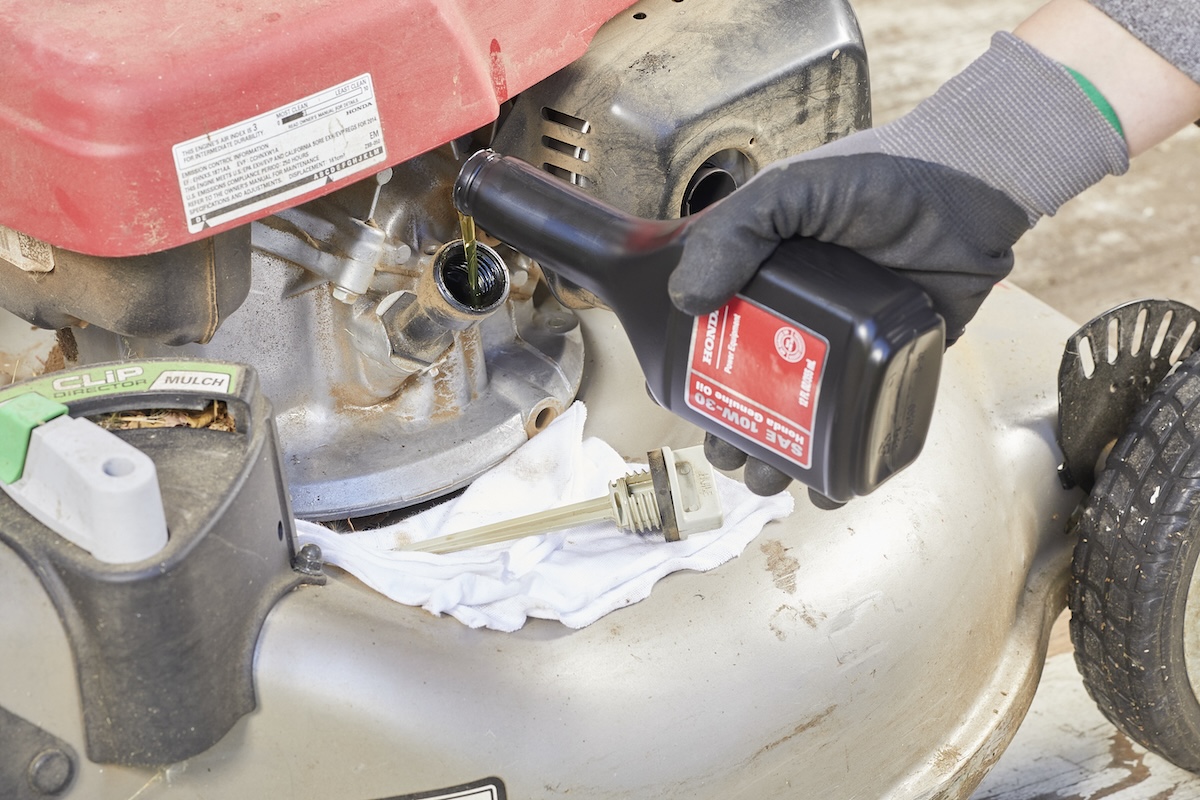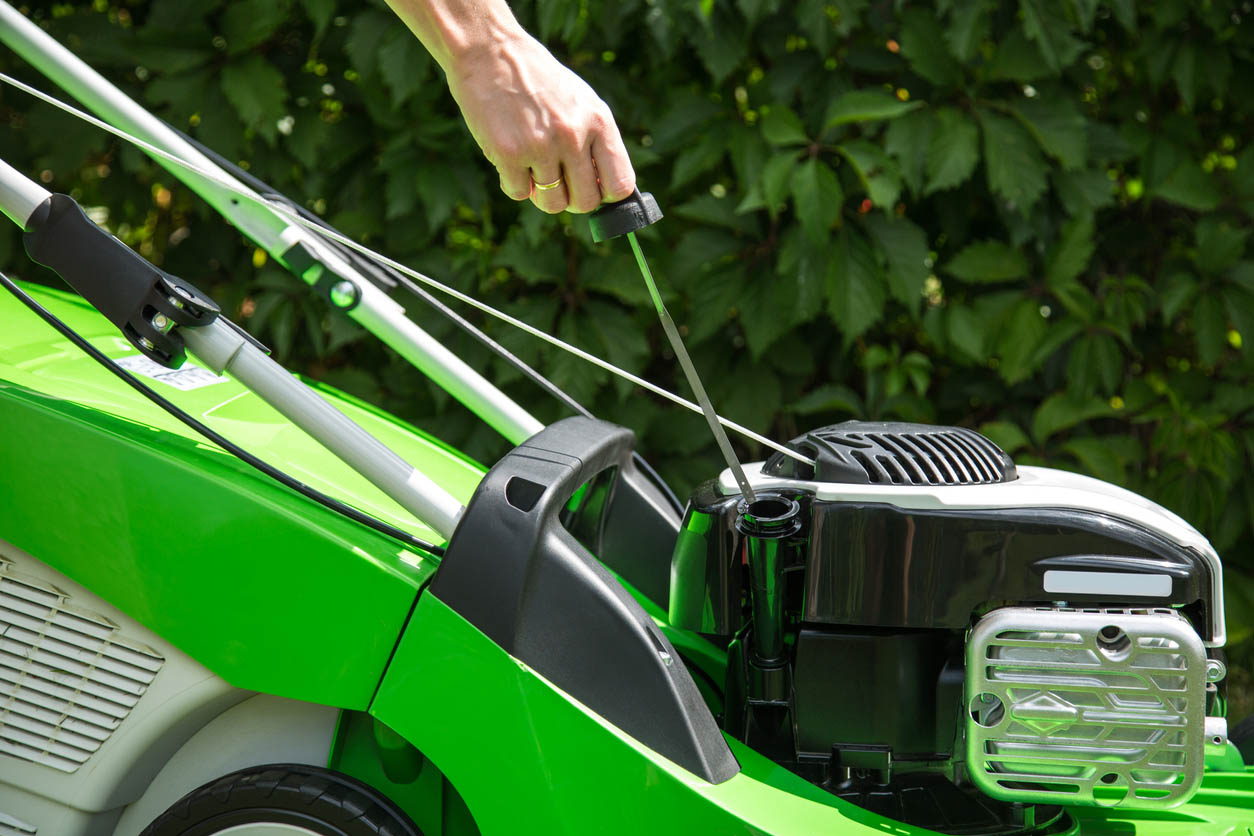We may earn revenue from the products available on this page and participate in affiliate programs. Learn More ›
Adding or changing oil for lawn mower engines is a critical part of regular lawn mower maintenance. How often you change lawn mower engine oil and what oil to use in a lawn mower depend on several factors. Your mower’s size, type, and capacity can determine which type of oil for your lawn mower is best.
Eduard Negodenko, landscaping expert at Avanti Landscaping in Toronto, Canada, says you should “consider factors such as engine type, temperatures at which the mower will be operated, and what the manufacturer recommends” when choosing oil for your lawn mower. Learn more below about oil designed specifically for these small engines.
Lawn Mower Oil Types

Every mower is different, and although you might assume you can use automotive oil in your mower, that’s not always the case. Automotive oil can be too thick for most lawn mowers and clog the small engines, even to the point of disabling them. Your best source when choosing the right lawn mower motor oil is the manufacturer, so always check their specifications first.
Products for lawn mowers might come in oil or synthetic forms, but how the oil grade (based on viscosity) works at various temperatures is more important. The first number tells how well the oil flows when the engine is cold, and the second number refers to its flow at normal engine-running temperatures.
- SAE 30 is a single-grade oil with a viscosity rating of 30. It works at warmer temperatures and is the most common oil used in small engines.
- SAE 10W-30 is a multigrade oil that can work within a fairly balanced temperature range.
- SAE 5W-30 is a multigrade engine oil that can flow better at colder temperatures than can 10W-30, but also protects the engine in heat.
- Synthetic SAE 5W-30 is a synthetic lawn mower oil for both cold and warm weather. It is more stable and protective across temperature ranges than conventional oils.
- Vanguard 15W-50 is a brand of fully synthetic engine oil designed for commercial applications that operates at temperatures ranging from 20 to 130 degrees Fahrenheit.
Lawn Motor Oil Viscosity
The oil grades mentioned above come from the Society of Automotive Engineers (SAE). Viscosity loosely relates to weight, or thickness, and more accurately as a measure of how the oil flows at specific temperatures. In colder temperatures, thinner single-grade oil typically performs better in engines.
Multigrade engine oil like SAE 5W-30 has low viscosity at colder temperatures and a higher viscosity (30) for hotter operating temperatures. Multigrade oils are designed to flow in a range of temperatures to match conditions. Some oils have additives that also keep viscosity steadier in cold or heat.
Lawn Mower Oil Capacity
It’s important to know how much oil a lawn mower takes along with the type when replacing or adding engine oil. The operator’s manual from the manufacturer should list this information, but use these figures as a general rule:
- The average push mower takes between 14 and 18 ounces of oil (about ½ quart).
- Riding mowers typically have an oil capacity of 48 to 64 ounces (1½ to 2 quarts).
Avoid overfilling your mower. Aside from the mess of spilled oil on the mower or the ground, having too much oil can cause engine problems that lead to a lawn mower smoking, sputtering, difficulty starting, overheating, or air filter clogging. Most mowers have a dipstick on the cap with notches to check the oil level. Use a small funnel to add oil gradually and check the dipstick after each fill.
How to Choose the Best Oil for Your Lawn Mower Engine

When choosing the best lawn mower engine oil for your mower, always start with the manufacturer recommendations. Consider the engine type along with viscosity and average running and ambient temperatures. For example, if you live in a climate that regularly reaches 100 degrees Fahrenheit, make sure the oil can handle that heat, such as SAE 30 or Synthetic SAE 5W-30.
Also check the mower’s operating manual or stickers on engines and fill caps to determine if it has a 2-stroke or 4-stroke engine.
Motor Oil for 4-Stroke Engines
Four-stroke engines tend to power heavy-duty equipment, but are reliable and your best bet for larger lawns. These engines are common in riding lawn mowers as well as some large push mowers, and have become more common than 2-stroke mowers in recent years. Even so, be sure to check your manufacturer’s manual or website for specific instructions on which grade of motor oil to use, since—much like a car—the engine might be sensitive to certain additives.
Oil and gas are kept separate in a 4-stroke engine. Oil with a grade of SAE-30 is often a safe bet, but it’s still worth confirming since a lawn mower isn’t a small investment.
Small Engine Oil for 2-Stroke Engines
This type of engine is most commonly found in smaller and older push mowers, plus other small engines, like those of weed trimmers and chainsaws. Louder and smokier than their 4-stroke counterparts, 2-stroke motors can keep running no matter how steep an angle you’re trying to tackle.
Two-stroke engines are lighter and cost less, too. Since they use the same fill port for both gasoline and small engine oil, 2-cycle motors require owners to mix them together in a specific ratio such as 32:1 or 50:1—refer to your operator’s manual for the correct gas-to-oil ratio.
Two-stroke engine oil for a push mower typically has additives to help clear carbon deposit and minimize wear.
How Often to Change Your Lawn Mower’s Oil

While you should check the fill level regularly before mowing, the frequency with which you should change lawn mower oil depends on several factors. Generally, change oil “after every 20 to 50 hours of operation,” says Steve Corcoran, CEO of Lawn Love. Although he admits this is a broad range, he says it depends on the specific mower. “Some [mowers] are simply built to need oil changes more or less frequently than others,” he explains.
If your yard is small, once a year might be sufficient. Many large mowers can run up to 50 hours before requiring oil replacement, though you will reach that point sooner on a large property. Other factors contribute to the frequency of oil changes: “Every 20 to 30 hours should apply to people working in dusty or extreme conditions,” says Negodenko. Conditions like rough terrain and frequent use on wet or muddy lawns can shorten the time between changes.
“Check the oil before each use for level and texture,” advises Negodenko. If the oil appears dark and gritty, it needs changing. Finally, make a point of draining the oil when you winterize your lawn mower or changing it each spring before your first mow.
How to Check Your Lawn Mower’s Oil Level

Checking a mower’s oil level is relatively straightforward and similar to checking automobile oil. For most lawn mowers, follow these steps:
- Park the mower on a level surface.
- Locate and unscrew the oil cap, checking the owner’s manual if you are not sure of its location.
- Wipe the dipstick with a clean rag and reinsert it, screwing the cap back on.
- Unscrew the cap again and look at the level of oil on the dipstick; it should be between the ‘full’ and ‘add’ marks (or holes).
- If the level hovers closer to the ‘add’ side, add a few ounces of oil and repeat the dipstick check to determine the new level.
How to Change Lawn Mower Oil
Changing the oil is part of a regular lawn mower maintenance regimen and involves some additional steps. Refer to the owner’s manual and accessories that came with your mower. Leave the mower on a level surface and place cardboard or a similar disposable barrier on the ground to keep it clean.
- Remove the spark plug if necessary.
- Clean around the oil reservoir cap and remove it.
- Drain the old oil completely; this will involve either finding a drain plug below the engineer or carriage, or tilting a push mower on its side to drain the oil into a pan. A riding mower requires a siphon pump or plastic drain sleeve (which might be included with the mower).
- Remove the dipstick and wipe it clean to allow the oil to flow into a catch pan. For a riding mower, attach the drain sleeve and then remove the drain plug. Remove it and replace the drain plug after the oil has drained.
- Replace the oil filter.
- Add new oil as recommended to fill the reservoir.
- Reinsert the dipstick to check the oil level.
- Reconnect the spark plug.
Tips for Choosing the Right Lawn Mower Oil
Avoid a costly mowing mistake by choosing the best oil for a lawn mower. “The wrong oil choice may bring about overheating, carbon buildup, and early engine failure,” says Negodenko. Take time to know what type of oil your lawn mower model uses. Several factors go into this decision:
In most cases, avoid other special additives for lawn mower oil, as most are not necessary. It is more important to keep up with regular oil changes and maintenance.
First and foremost, go with the specific oil type suggested by the lawn mower manufacturer for your make and model.
Unless your owner’s manual specifically says to avoid synthetic oil, use a synthetic lawn mower oil to help maintain the engine and its performance; it does not affect how often oil needs changing.
Most manufacturers recommend a high-quality detergent oil for small engines like mowers. Detergent oils are synthetic products with some additives that help engines stay cleaner and last longer by fighting rust and sludge. Most manufacturers recommend detergent oil. Non-detergent oils lack anti-rust and other additives and can lead to sludge buildup from dirt particles.
FAQs
Lawn mowers with 4-stroke engines might do fine with regular motor oil, but always check the manufacturer documentation to make sure. Some automotive oils are too high in viscosity and meant for larger engines. Many deluxe models of push mowers and riding mowers use regular motor oil.
Two-stroke engines cannot use motor oil; they need a mix of fuel and oil specially designed for small engines.
The best oil for lawn equipment is the one recommended by the manufacturer. Selecting oil for viscosity and whether the oil is synthetic or regular oil can vary based on climate, conditions, and engine type.
No, it is not recommended. Most engines that call for SAE 30 are older models of mowers with engines designed for straight weight oil. These models were designed before multigrade oil became available, so you should not substitute with the multigrade option.

